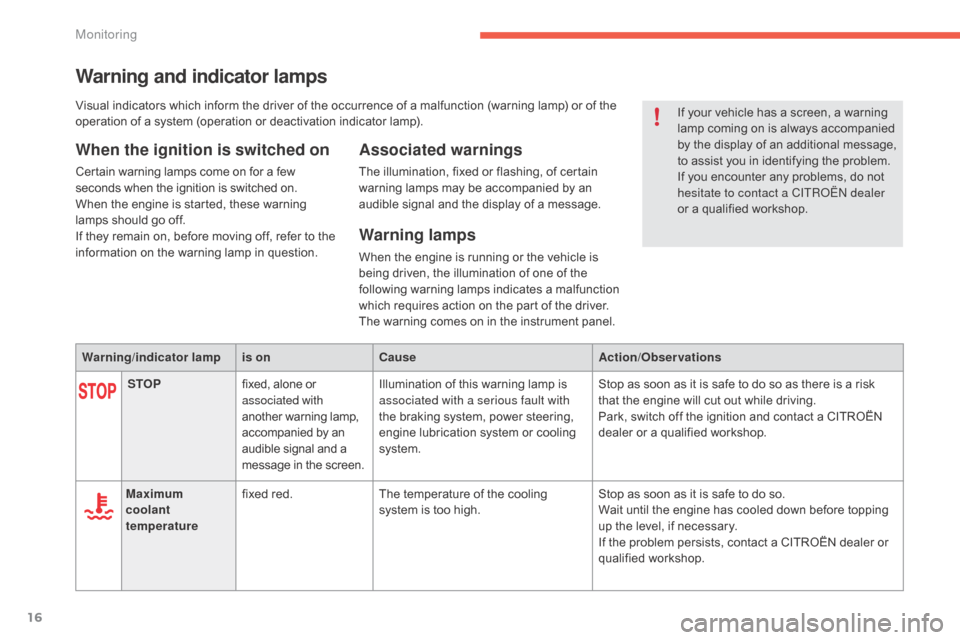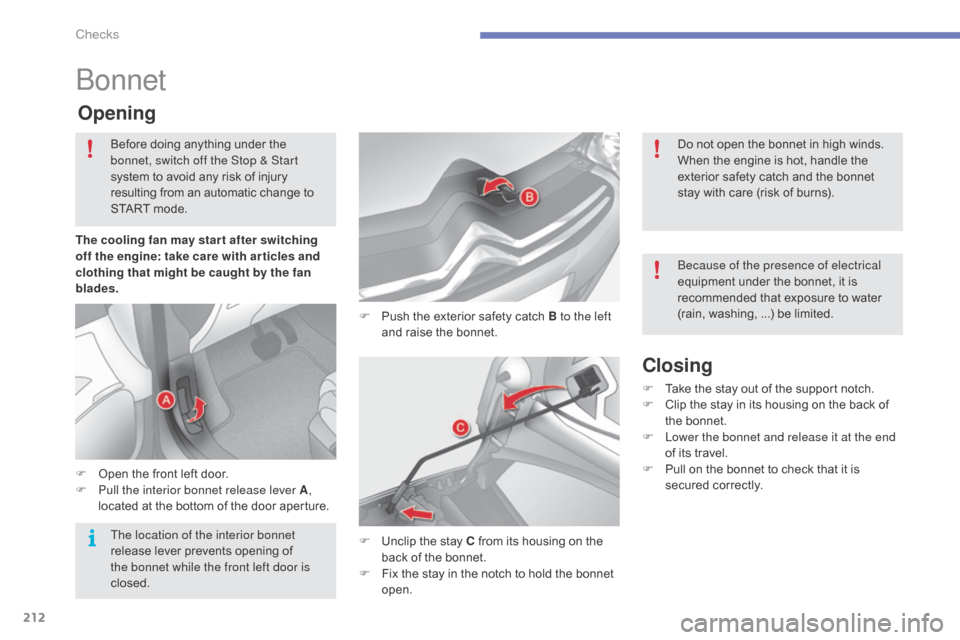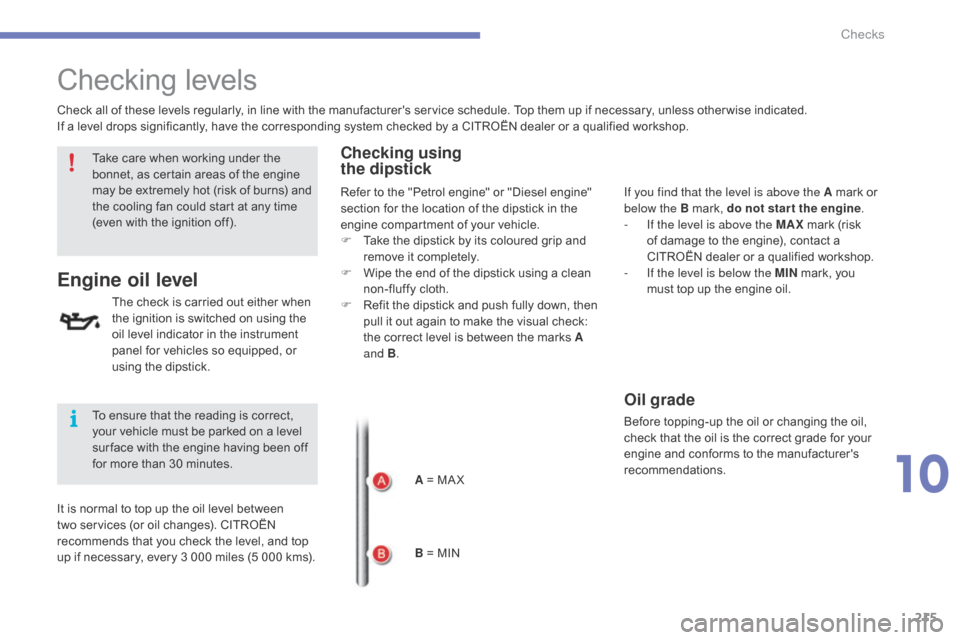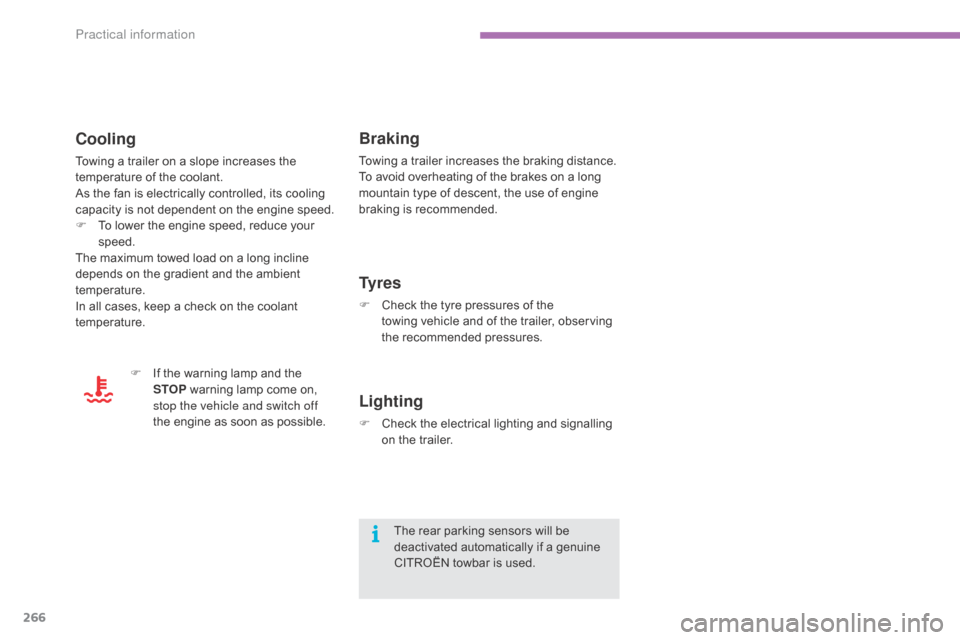cooling Citroen C4 2015 2.G Owner's Manual
[x] Cancel search | Manufacturer: CITROEN, Model Year: 2015, Model line: C4, Model: Citroen C4 2015 2.GPages: 494, PDF Size: 20.49 MB
Page 18 of 494

16
C4-2_en_Chap01_controle-de-marche_ed01-2015
C4-2_en_Chap01_controle-de-marche_ed01-2015
Warning and indicator lamps
When the ignition is switched on
Certain warning lamps come on for a few seconds   when   the   ignition   is   switched   on.
When
  the   engine   is   started,   these   warning  
l
amps   should   go   off.
If
  they   remain   on,   before   moving   off,   refer   to   the  
i
nformation   on   the   warning   lamp   in   question.
Associated warnings
The illumination, fixed or flashing, of certain warning   lamps   may   be   accompanied   by   an  
a
udible   signal   and   the   display   of   a   message.
Warning lamps
When the engine is running or the vehicle is being   driven,   the   illumination   of   one   of   the  
fo
llowing
 w
arning
 lam
ps
 in
dicates
 a m
alfunction
 w
hich   requires   action   on   the   part   of   the   driver.
The
  warning   comes   on   in   the   instrument   panel.
Warning /indicator lampis on Cause Action/Observations
STOP fixed,
 
alone
 
or
 a
ssociated with
another
 w
arning
 lam
p,
 a
ccompanied
 
by
 
an
 a
udible
 
signal
 
and
 
a
 m
essage
 
in
 
the
 
screen. Illumination
  of   this   warning   lamp   is  
a
ssociated with a serious fault with
the
  braking   system,   power   steering,  
e
ngine   lubrication   system   or   cooling  
s
ystem. Stop
  as   soon   as   it   is   safe   to   do   so   as   there   is   a   risk  
t
hat   the   engine   will   cut   out   while   driving.
Park,
¬† switch ¬† off ¬† the ¬† ignition ¬† and ¬† contact ¬† a ¬† CITRO√čN ¬†
d
ealer   or   a   qualified   workshop.
Maximum
coolant
temperature fixed
 
red. The
  temperature   of   the   cooling  
s
ystem   is   too   high. Stop
  as   soon   as   it   is   safe   to   do   so.
Wait
  until   the   engine   has   cooled   down   before   topping  
u
p   the   level,   if   necessary.
If
¬† the ¬† problem ¬† persists, ¬† contact ¬† a ¬† CITRO√čN ¬† dealer ¬† or ¬†
q
ualified
 w
orkshop.If
  your   vehicle   has   a   screen,   a   warning  
l
amp   coming   on   is   always   accompanied  
b
y   the   display   of   an   additional   message,  
t
o   assist   you   in   identifying   the   problem.
If   you   encounter   any   problems,   do   not  
h
esitate to contact a CITR
o√čn
dealer
or   a   qualified   workshop.
Visual
 
indicators
 
which
 
inform
 
the
 
driver
 
of
 
the
 
occurrence   of   a   malfunction   (warning   lamp)   or   of   the  
o
peration
 
of
 
a
 
system
 
(operation
 
or
 
deactivation
 
indicator   lamp).
Monitoring
Page 81 of 494

79
C4-2_en_Chap04_confort_ed01-2015
C4-2_en_Chap04_confort_ed01-2015
Ventilation
Air intake
The air circulating in the passenger compartment   is   filtered   and   originates   either  
f
rom   the   outside   via   the   grille   located   at   the  
b
ase   of   the   windscreen   or   from   the   inside   in   air  
re
circulation
 m
ode.
Air treatment
The incoming air follows various routes depending   on   the   controls   selected   by   the  
d
river:
-
 
d
irect   arrival   in   the   passenger  
c
ompartment   (air   intake),
-
 
p
assage   through   a   heating   circuit   (heating),
-
 
p
assage   through   a   cooling   circuit   (air  
c
onditioning).
Control panel
The controls of this system are grouped together   on   control   panel   A on the centre
console.
Air distribution
1. Windscreen d emisting-defrosting v ents.
2. F ront   side   window   demisting-defrosting  
ve
nts.
3.
 S
ide   adjustable   air   vents.
4.
 C
entral   adjustable   air   vents.
5.
 A
ir   outlets   to   the   front   footwells.
6.
 A
ir   nozzles   to   the   front   footwells.
7.
 A
ir   outlets   to   the   rear   footwells.
4
Comfort
Page 87 of 494

85
C4-2_en_Chap04_confort_ed01-2015
C4-2_en_Chap04_confort_ed01-2015
See "Front demisting - defrosting".
4. Automatic visibility programmeIf you wish, you can make a different choice f
rom   that   offered   by   the   system   by   changing  
a
  setting.   The   the   "AUTO"
 
indicator   lamps   go  
o
ff;   the   other   functions   will   still   be   controlled  
au
tomatically.
F
 
P
ressing   the   "AUTO" button returns the
system
  to   completely   automatic   operation.2. Driver's side adjustment
The driver and front passenger can each   adjust   the   temperature   to   their  
r
equirements.
F
T
urn control 2 or 3   to   the   left   or   to   the   right  
r
espectively to decrease or increase this
value.
A
 
setting
 
around   the   value   21   provides  
o
ptimum
 
comfort.   However,   depending   on   your  
r
equirements,   a   setting   between   18   and   24   is  
n
ormal.
You
 
are
 
advised   to   avoid   a   left   /   right   setting  
d
ifference
 
of   more   than   3.
3. Passenger's side adjustment
The value indicated on the display corresponds
to  a   level   of   comfort   and   not   to   a   temperature   in  
d
egrees   Celsius   or   Fahrenheit. With
  Stop   &   Start,   when   demisting   has  
b
een   activated,   the   STOP   mode   is   not  
a
vailable.For
  maximum   cooling   or   heating   of   the  
p
assenger   compartment,   it   is   possible  
t
o   exceed   the   minimum   value   14   or   the  
m
aximum   value   28.
F
T
urn control 2 or 3 to the left until
"LO"
  is   displayed   or   to   the   right  
u
ntil "HI"
 
is   displayed.
Manual operation
4
Comfort
Page 214 of 494

212
C4-2_en_Chap10_verification_ed01-2015
C4-2_en_Chap10_verification_ed01-2015
bonnet
F Push  the   exterior   safety   catch   B to the left
and   raise   the   bonnet.
Opening
F Open  the   front   left   door.
F P ull the interior bonnet release lever A,
located
  at   the   bottom   of   the   door   aperture.
F
 
U
nclip   the   stay   C   from   its   housing   on   the  
b
ack   of   the   bonnet.
F
 
F
ix   the   stay   in   the   notch   to   hold   the   bonnet  
ope
n.
Closing
F Take  the   stay   out   of   the   support   notch.
F  C lip   the   stay   in   its   housing   on   the   back   of  
t
he   bonnet.
F
L
ower the bonnet and release it at the end
of
  its   travel.
F
 
P
ull   on   the   bonnet   to   check   that   it   is  
s
ecured
 c
orrectly.
The cooling fan may star t after switching
off the engine: take care with ar ticles and
clothing that might be caught by the fan
blades.
Before
 
doing
 
anything
 
under
 
the
 
b
onnet, switch off the Stop & Start
system
 
to
 
avoid
 
any
 
risk
 
of
 
injury
 
r
esulting
 
from
 
an
 
automatic
 
c
hange
 t
o
 S
TART
 
mode.
Do  not   open   the   bonnet   in   high   winds.
When   the   engine   is   hot,   handle   the  
e
xterior   safety   catch   and   the   bonnet  
s
tay   with   care   (risk   of   burns).
be
cause of the presence of electrical
equipment   under   the   bonnet,   it   is  
r
ecommended   that   exposure   to   water  
(
rain,   
w
ashing,   ...)   be   limited.
The location of the interior bonnet
release
 
lever
 
prevents
 
opening
 
of
 
t
he bonnet while the front left door is
closed.
Checks
Page 217 of 494

215
C4-2_en_Chap10_verification_ed01-2015
C4-2_en_Chap10_verification_ed01-2015
Checking levels
The check is carried out either when the   ignition   is   switched   on   using   the  
o
il   level   indicator   in   the   instrument  
p
anel   for   vehicles   so   equipped,   or  
u
sing   the   dipstick.
Engine oil level
Checking using
the dipstick
Check all of these levels regularly, in line with the manufacturer's service schedule. Top them up if necessary, unless other wise indicated.
I f ¬† a ¬† level ¬† drops ¬† significantly, ¬† have ¬† the ¬† corresponding ¬† system ¬† checked ¬† by ¬† a ¬† CITRO√čN ¬† dealer ¬† or ¬† a ¬† qualified ¬† workshop.
It
  is   normal   to   top   up   the   oil   level   between  
t
wo ¬† services ¬† (or ¬† oil ¬† changes). ¬† CITRO√čN ¬†
r
ecommends   that   you   check   the   level,   and   top  
u
p   if   necessary,   every   3   000   miles   (5   000   kms).A
  =   MA X
B
  =   MINIf you find that the level is above the A
  mark   or  
belo
w the B   mark,   do not star t the engine.
-
I
f the level is above the MAX
 
mark   (risk  
o
f   damage   to   the   engine),   contact   a  
C
ITRO√čN ¬† dealer ¬† or ¬† a ¬† qualified ¬† workshop.
-
I
f the level is below the MIN
 
mark,   you  
m
ust   top   up   the   engine   oil.
Oil grade
Before topping-up the oil or changing the oil, check   that   the   oil   is   the   correct   grade   for   your  
e
ngine   and   conforms   to   the   manufacturer's  
r
ecommendations.
Take
 
care
 
when
 
working
 
under
 
the
 
b
onnet,
 
as
 
certain
 
areas
 
of
 
the
 
engine
 
m
ay
 
be
 
extremely
 
hot
 
(risk
 
of
 
burns)
 
and
 
t
he
 
cooling
 
fan
 
could
 
start
 
at
 
any
 
time
 
(
even
 
with
 
the
 
ignition
 
off).
To
 
ensure
 
that
 
the
 
reading
 
is
 
correct,
 y
our
 
vehicle
 
must
 
be
 
parked
 
on
 
a
 
level
 
s
ur face
 
with
 
the
 
engine
 
having
 
been
 
off
 
f
or
 
more
 
than
 
30
 
minutes. Refer
 
to
 
the
 
"Petrol
 
engine"
 
or
 
"Diesel
 
engine"
 
s
ection
 
for
 
the
 
location
 
of
 
the
 
dipstick
 
in
 
the
 
e
ngine
 
compartment
 
of
 
your
 
vehicle.
F
 
T
ake
 
the
 
dipstick
 
by
 
its
 
coloured
 
grip
 
and
 
r
emove
 
it
 
completely.
F
 
W
ipe
 
the
 
end
 
of
 
the
 
dipstick
 
using
 
a
 
clean
 
n
on-fluffy
 
cloth.
F
 
R
efit
 
the
 
dipstick
 
and
 
push
 
fully
 
down,
 
then
 
p
ull
 
it
 
out
 
again
 
to
 
make
 
the
 
visual
 
check:
 
t
he
 
correct
 
level
 
is
 
between
 
the
 
marks
 
A
and B .
10
Checks
Page 219 of 494

217
C4-2_en_Chap10_verification_ed01-2015
C4-2_en_Chap10_verification_ed01-2015
Screenwash / headlamp
wash fluid level
Specification of the fluid
To ensure optimum cleaning and to avoid freezing,   the   fluid   should   never   be   topped   up   or r
eplaced   by   plain   water.
In wintry conditions, the use of a fluid
with
  an   ethyl   alcohol   or   methanol   base   is  
re
commended.
To
 
check
 
the
 
level
 
or
 
top
 
up
 
the
 
f
luid
 
on
 
vehicle
 
fitted
 
with
 
headlamp
 
w
ashers,
 
immobilise
 
the
 
vehicle
 
and
 
s
witch
 
of
 
the
 
engine.
F
o
p
en the bonnet and secure it with the
st ay.
F
 
O
pen
 
the
 
screenwash
 
reservoir
 
filler
 
cap.
F
 
T
ake
 
and
 
pinch
 
the
 
level
 
gauge
 
to
 
block
 
its
 
b
reather.
F
 
R
emove
 
the
 
gauge
 
completely
 
from
 
t
he reservoir to read the level in the
transparent
 s
ection.
Coolant level
The coolant level should be close
to   the   "MA X"   mark   but   should   never  
e
xceed   it.
Fluid specification
The coolant must conform to the manufacturer's r ecommendations.
The cooling fan may star t after
switching off the engine: take care
with articles and clothing that might
be caught by the fan blades.
When
  the   engine   is   warm,   the   temperature   of  
t
he   coolant   is   regulated   by   the   fan.
In   addition,   as   the   cooling   system   is  
p
ressurised, wait at least one hour after
switching   off   the   engine   before   carrying   out  
any   work.
To   avoid   any   risk   of   scalding,   unscrew   the   cap  
b
y   two   turns   to   allow   the   pressure   to   drop.  
W
hen   the   pressure   has   dropped,   remove   the  
c
ap   and   top   up   the   level. F  
T
op   up   if   necessary.
F
R
efit the filler cap to the reservoir and
close   the   bonnet.
10
Checks
Page 268 of 494

266
C4-2_en_Chap11_info-pratique_ed01-2015
C4-2_en_Chap11_info-pratique_ed01-2015
F If  the   warning   lamp   and   the  S
TOP  warning   lamp   come   on,  
s
top the vehicle and switch off
the
  engine   as   soon   as   possible.
Braking
Towing a trailer increases the braking distance.
T o   avoid   overheating   of   the   brakes   on   a   long  
m
ountain   type   of   descent,   the   use   of   engine  
b
raking   is   recommended.
Ty r e s
F Check   the   tyre   pressures   of   the  
towing   vehicle   and   of   the   trailer,   observing  
t
he
 re
commended
 p
ressures.
Lighting
F Check  the   electrical   lighting   and   signalling  o
n   the   trailer.
The
  rear   parking   sensors   will   be  
d
eactivated   automatically   if   a   genuine  
C
ITRO√čN ¬† towbar ¬† is ¬† used.
Cooling
Towing a trailer on a slope increases the temperature   of   the   coolant.
As
  the   fan   is   electrically   controlled,   its   cooling  
c
apacity   is   not   dependent   on   the   engine   speed.
F
 
T
o   lower   the   engine   speed,   reduce   your  
s
peed.
The
  maximum   towed   load   on   a   long   incline  
d
epends   on   the   gradient   and   the   ambient  
t
emperature.
In
  all   cases,   keep   a   check   on   the   
c
oolant  
t
emperature.
Practical information